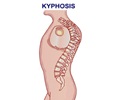Vosoritide, if started early, helps kids with achondroplasia to achieve a normal or near normal growth rate.

‘Vosoritide, an analogue of C-type natriuretic peptide, acts by preventing the inhibition of mineralization of chondrocytes caused by the FGFR3 gene mutation.’
Read More..




Physical complications include the narrowing of the foremen magnum, an opening at the base of the skull through which the spinal cord passes, potentially compressing the spinal cord and putting the child at risk for sudden death if left unrecognized and untreated. Shortening of the base of the skull also causes the foreshortening of the nasopharynx, which can lead to upper airway obstruction and obstructive apnea. Read More..
On a biochemical level, achondroplasia occurs when there is a mutation in the FGFR3 gene, and this mutation causes the gene receptor to act as if a ligand called the fibroblast growth factor is bound to it. This then inhibits the mineralization of chondrocytes, or cartilage cells, in the growth plate, the growing tissue near the ends of the long bones.
In roughly 80 percent of individuals who have achondroplasia, the condition develops as a result of a random mutation in the FGFR3 gene during formation of the egg or sperm prior to fertilization, and neither parent has the condition. The remaining 20 percent of people with achondroplasia inherit the genetic condition from at least one of their parents who have achondroplasia.
Surgery is common among individuals with achondroplasia, which can help alleviate physical complications from bone problems and promote better quality of life. Limb lengthening surgery is also an option, but isn’t popular in the United States as it requires multiple surgeries over a long period of time and presents high risk of infection, according to Charrow.
Vosoritide, on the other hand, is the first drug of its kind, acting by increasing bone growth in children with achondroplasia. The drug is essentially an analogue for a naturally occurring substance in the body called C-type natriuretic peptide and prevents the inhibition of the mineralization of chondrocytes caused by the FGFR3 gene mutation. This double-negative inhibition then permits the chondrocytes to proliferate and mineralize normally, ultimately increasing bone growth.
Advertisement
Overall, those who received vosoritide daily saw an increase in growth velocity of 1.57 centimeters (0.6 inches) per year by the end of the trial period. This growth velocity is similar to what is considered normal for this age group, according to Dr. Charrow.
“If the drug does mitigate those other physical problems, then there’s no question in my mind that it would be beneficial because it would prevent morbidity and potential mortality,” Dr. Charrow added.
As for next steps, additional clinical trials for the drug are currently underway and involve participants with achondroplasia who are under the age of six months, with the aim of determining the drug’s effectiveness over a longer period of time.
“The hope and expectation are that if this therapy is started early, we can achieve a normal or near-normal growth rate. What we’re hoping, but remains to be seen, is whether some of the other things that go along with achondroplasia, like the narrowing of the foramen magnum and upper airway problems, are also mitigated by this therapy,” Dr. Charrow said.
This work was funded by BioMarin Pharmaceutical.
Research at Ann & Robert H. Lurie Children’s Hospital of Chicago is conducted through the Stanley Manne Children’s Research Institute.
The Manne Research Institute is focused on improving child health, transforming pediatric medicine and ensuring healthier futures through the relentless pursuit of knowledge. Lurie Children’s is ranked as one of the nation’s top children’s hospitals by U.S. News & World Report. It is the pediatric training ground for Northwestern University Feinberg School of Medicine. Last year, the hospital served more than 220,000 children from 48 states and 49 countries.
Source-Newswise










